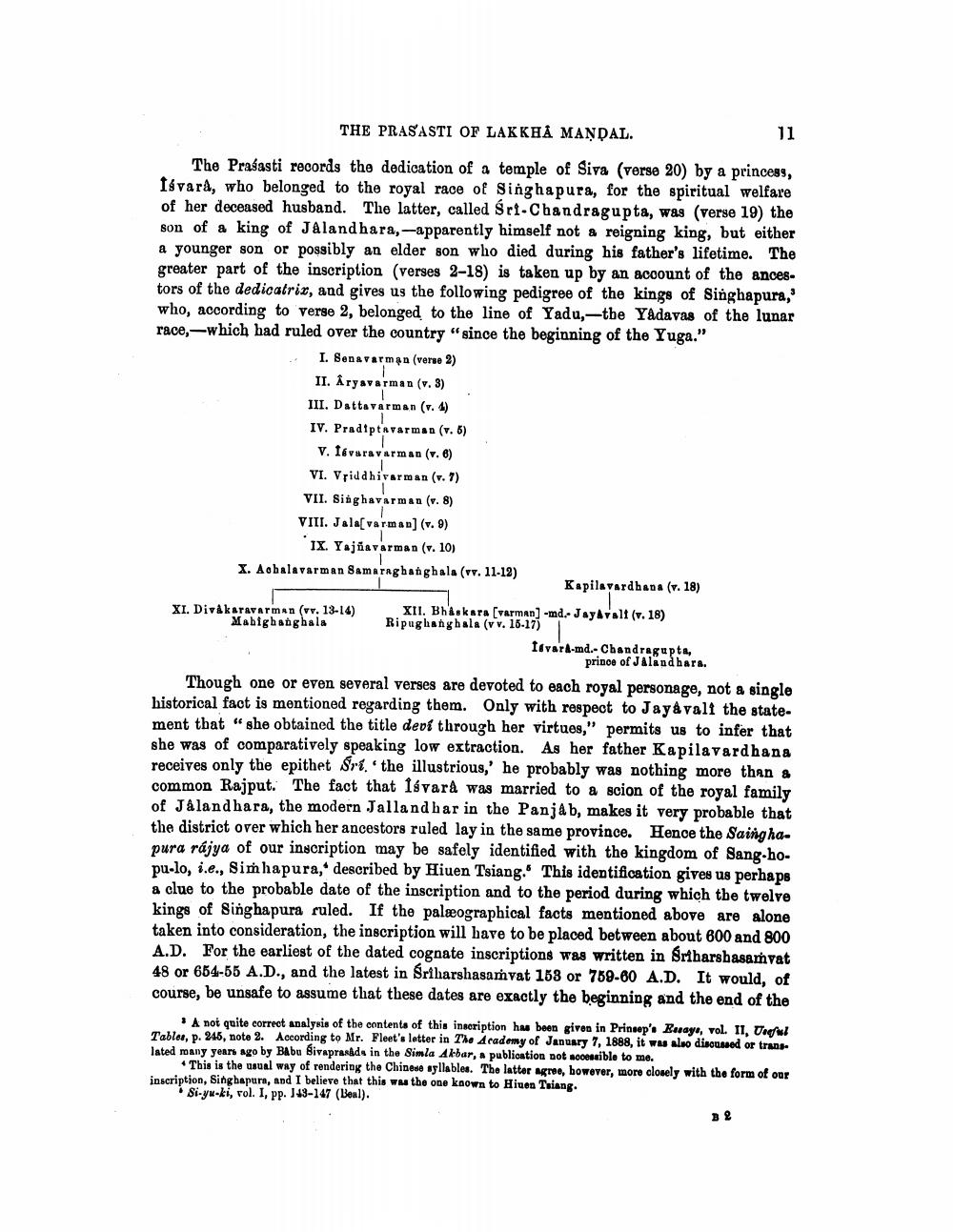________________
11
THE PRASASTI OF LAKKHA MANDAL. The Prasasti records the dedication of a temple of Siva (verse 20) by a princess, Isvara, who belonged to the royal race of Singhapura, for the spiritual welfare of her deceased husband. The latter, called Sri Chandragupta, was (verse 19) the son of a king of Jalandhara, -apparently himself not a reigning king, but either a younger son or possibly an elder son who died during his father's lifetime. The greater part of the inscription (verses 2-18) is taken up by an acoount of the ancestors of the dedicatriz, and gives us the following pedigree of the kings of Singhapura, who, according to verse 2, belonged to the line of Yadu,--the Yadavas of the lunar race, which had ruled over the country "since the beginning of the Yuga."
I. Bonavarman (verse 2) II. Aryavarman (v. 3) III. Dattavarman (v.4) IV. Pradiptavarman (5.5)
v. favuravarman (v. 6) VI. Vriddhivarman (v.7) VII. Singhavarman (v. 8) VIII. Jalavarman] (v. 9)
IX. Yajñavarman (v. 10) X. Aobalavarman Samaraghanghala (vv. 11-12)
Kapilarardhana (v. 18) XI. Divakaravarman (vv. 13-14) XII. Bhakara (varman] -md-JayAvalt (v. 18) Mabighanghala Ripughanghala (vv. 16-17)
firard-md.- Chandragupte,
prince of Jalandhara. Though one or even several verses are devoted to each royal personage, not a single historical fact is mentioned regarding them. Only with respect to Jayavalt the statement that "she obtained the title dedi through her virtues," permits us to infer that she was of comparatively speaking low extraction. As her father Kapilavardhana receives only the epithet Sri. the illustrious,' he probably was nothing more than & common Rajput. The fact that Išvard was married to a scion of the royal family of Jalandhara, the modern Jalland har in the Panjab, makes it very probable that the district over which her ancestors ruled lay in the same province. Hence the Sainghapura rajya of our inscription may be safely identified with the kingdom of Sang-hopu-lo, i.e., Simhapura, described by Hiuen Tsiang. This identification gives us perhaps a clue to the probable date of the inscription and to the period during which the twelve kings of Singhapura ruled. If the palæographical facts mentioned above are alone taken into consideration, the inscription will have to be placed between about 600 and 800 A.D. For the earliest of the dated cognate inscriptions was written in Sriharshasarvat 48 or 654-55 A.D., and the latest in Sriharshasamvat 153 or 759-80 A.D. It would, of course, be unsafe to assume that these dates are exactly the beginning and the end of the
A not quite correct analysis of the contents of this inscription has been given in Prinsep's Buay, vol. II, Undful Tables, p. 245, note 2. According to Mr. Fleet's letter in the Academy of January 7, 1888, it was also discussed or translated many years ago by Babu Bivaprasade in the Simla Akbar, a publication not accessible to me.
This is the usual way of rendering the Chinese syllables. The latter agree, bowever, more closely with the form of our inscription, Singhapura, and I believe that this was the one kaown to Hiuen Triang.
Si-yu-ki, vol. I, pp. 149-147 (Beul).




